Autos
High-end hybrids have come a long way
Lexus LS 500H, Mini Cooper SE Countryman among ’19 standouts
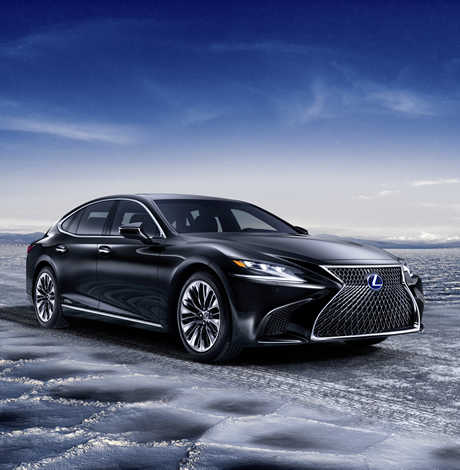
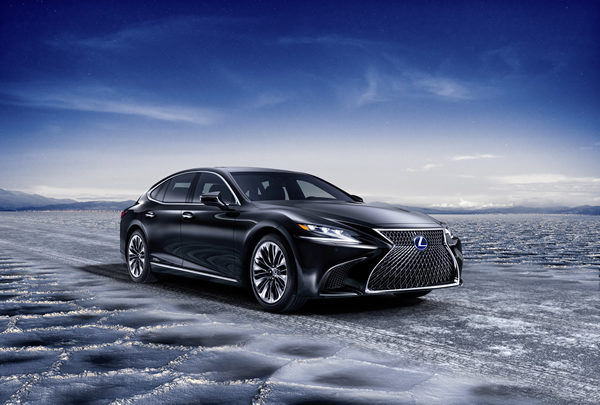
The first hybrid car, built by Ferdinand Porsche, no less, had its coming-out party at the Paris World’s Fair in 1900. Yet it took almost 100 years for mass-produced hybrids to make their debut in dealer showrooms. Sure, the Toyota Prius quickly became the belle of the ball, but now automakers are showcasing gas-sippers with much more snob appeal.
LEXUS LS 500H
$85,000
MPG: 26 city/31 highway
Zero-60 mph: 5.4 seconds
Lexus introduced the first luxury hybrid — a version of the midsize RX crossover — back in 2005. But to show just how seriously the automaker wants to be an eco-chic crusader, the lavish LS 500h hybrid sedan is the company’s overall flagship vehicle.
At over 206 inches in length, this full-size ride is plenty big, with acres of legroom and trunk space. Yet the car feels light and airy, with swift acceleration and no roly-poly wobbling as you weave through traffic. Redesigned last year, the LS 500h now has Apple CarPlay (though no Android Auto), as well as Amazon Alexa to start the engine, lock/unlock the doors and check the fuel level.
There’s a laundry list of standard safety and comfort features, but it’s hard to resist many over-the-top options: 23-speaker Mark Levinson stereo, 24-inch head-up display and 28-way adjustable seats that can heat up, cool down and massage you to paradise. Despite the severely sloped roofline, the rear seats recline to help tall passengers fit comfortably. The glam interior is eerily quiet, with four-zone climate control, power sunshades and ritzy, hand-pleated Alcantara door panels that look like premium acoustic material from a high-tech sound studio.
The overall design, both inside and out, is bold and angular. While the BMW 745e and Mercedes 560e plug-in hybrids may be more performance-oriented, the LS 500h is just as glamorous and boasts a key Lexus selling point: superb reliability.
MINI COOPER SE COUNTRYMAN ALL4 PHEV
$37,000
MPG: 65 in electric/gasoline mode
Zero-60 mph: 6.7 seconds
Cute. Compact. Classy. The Mini Cooper SE Countryman plug-in hybrid is built on the same platform as the itty BMW X1 crossover, with some rather wonky styling and a host of high-end features.
The ride is sporty rough, which means your tush feels each and every pothole. But that’s a good thing, because the steering and suspension are tight and controlled. There’s plenty of Euro cred here, from the zippy acceleration to the high-quality materials, which helps differentiate this Mini plug-in hybrid from a bevy of other smallish, ho-hum hybrids. And to help it stand out from other Minis, as well, this Countryman is available with funky neon green paint on the side-view mirrors, the charge port, each of the four wheels, and the badging on the grille and rear hatch.
When the battery is being charged, a pulsing light encircling the charge port also glows green. Fully charged, the range is up to 270 miles. In electric-only mode, the range is about 12 miles — though this increases to 35 miles on the 2020 model. Inside, the large, circular infotainment system also glows green, as well as other colors.
The cabin feels roomy, though there could be a few more storage compartments. But there are plenty of luxe amenities: push-button start, heated windshield wiper system, simulated leather upholstery, power-folding mirrors, power liftgate, suede headliner, panoramic sunroof and more. By combining these creature comforts with a fuel-friendly powerplant and some whimsical design cues, Mini has produced one fun hybrid.

RANGE ROVER SPORT HSE MHEV
$74,000
MPG: 19 city/25 highway
Zero-60 mph: 6.2 seconds
The Sport is Range Rover’s first mild-hybrid vehicle, available with 355 hp or 395 hp. While curb weight is 5,135 pounds, this husky SUV is surprisingly agile.
A best-in-class chassis helps, offering a pillow-like ride whether ferrying passengers over rocky terrain or breezing down the freeway. Acceleration is downright sprightly, with vise-like brakes that quickly stop the Sport but without any herky-jerky shuddering common on some other large SUVs.
With such high ground clearance, the self-leveling air suspension lowers the vehicle to easily load passengers or cargo. Inside, the cabin is so refined it should be in Architectural Digest, with sculpted wood trim, real leather seats, ambient lighting and a fixed panoramic sunroof. Third-row seating is an option, though there’s only room for kids or pets.
All the latest safety gear is here, including blind-sport monitoring, forward collision warning (with automatic emergency braking), a driver-monitoring system and traffic-sign recognition. The puddle lamps add a touch of class, as do heated/ventilated front and rear seats.
And while there are numerous stereo configurations, offering umpteen speakers depending on how much you want to spend, the infotainment system has a tendency to periodically conk out or freeze on a particular radio station. That’s annoying, considering how much the Sport costs. But drivers may overlook such a glitch because the sound quality is so stunning the rest of the time.
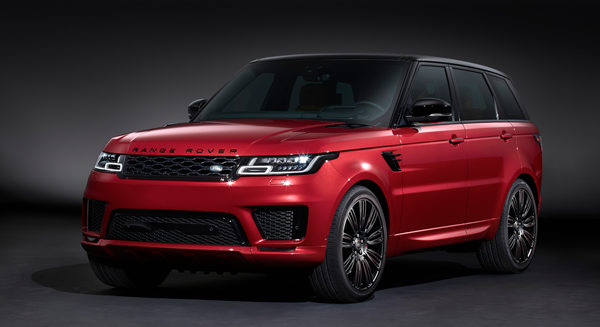
Autos
Sporty sedans: BMW 530i xDrive, Mercedes AMG CLA 3
Tariffs are here and the result is financial chaos
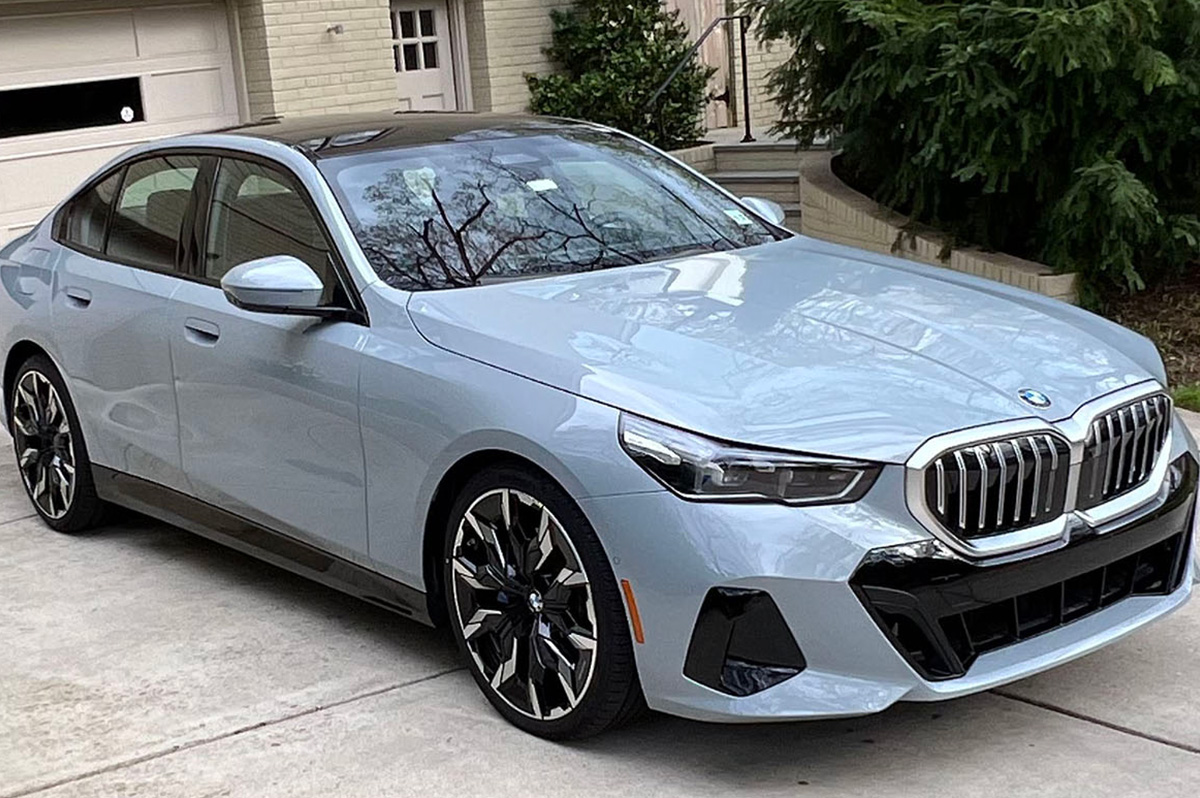
It’s official: Tariffs are here, and the result is financial chaos.
So, what to do when purchasing a new vehicle? If you need one in the not-so-distant future, buy sooner (like yesterday) rather than later. Expect prices to rise quickly, as inventory dwindles, demand soars, and automaker incentives evaporate. Of course, if a new ride isn’t a priority for at least a year or three, then hold off until the dust settles.
But for those of you looking for new wheels now, I recently drove two sport sedans that were a pleasant reprieve from the usual plethora of pickups, minivans, and SUVs.
BMW 530i xDRIVE
$63,000
MPG: 28 city/35 highway
0 to 60 mph: 5.5 seconds
Cargo space: 18.4 cu. ft.
PROS: Rakish looks. Race-car vibe. Rock-star amenities.
CONS: Rad-but-quirky infotainment system. Rich price.
IN A NUTSHELL: Classic good looks, from the iconic grille and swept-back headlights to chiseled side panels and a tasteful tush. For a gearhead like me, the BMW 530i xDrive — completely redesigned last year — is as rapturous as Michelangelo’s David. Everything here is in proportion, from the design to the drivetrain, which — along with a gutsy 255-hp turbo and all-wheel drive — helps deliver a divine experience behind the wheel. Even better, my test car came equipped with the heavenly M-Sport Package: 21-inch wheels, athletic suspension, and assorted styling upgrades.
A tech-laden cabin is outfitted with a sparkly 12.3-inch digital instrument cluster and 14.9-inch touchscreen infotainment system. With the windshield head-up display and a slew of knobs and toggle switches in the center console and on the steering wheel, I wondered if this is how it feels to pilot the Space Shuttle. There is even a back-lit interaction bar with touch-sensitive controls to adjust vent direction and other climate control settings.
All this gadgetry takes some getting used to, but the overall effect is dazzling. While a 12-speaker Harman Kardon stereo comes standard, I was jammin’ to the 16-speaker Bowers & Wilkins premium audio. Of course, such options add up quickly (on my test car, the extras totaled $13,000).
Just how fun is this car? In my favorite episode of “Hacks,” sassy Jean Smart drives a rockin’ Rolls Royce Wraith. Trust me, this four-door BMW is every bit the badass as that $300,000 super coupe.
MERCEDES AMG CLA 35
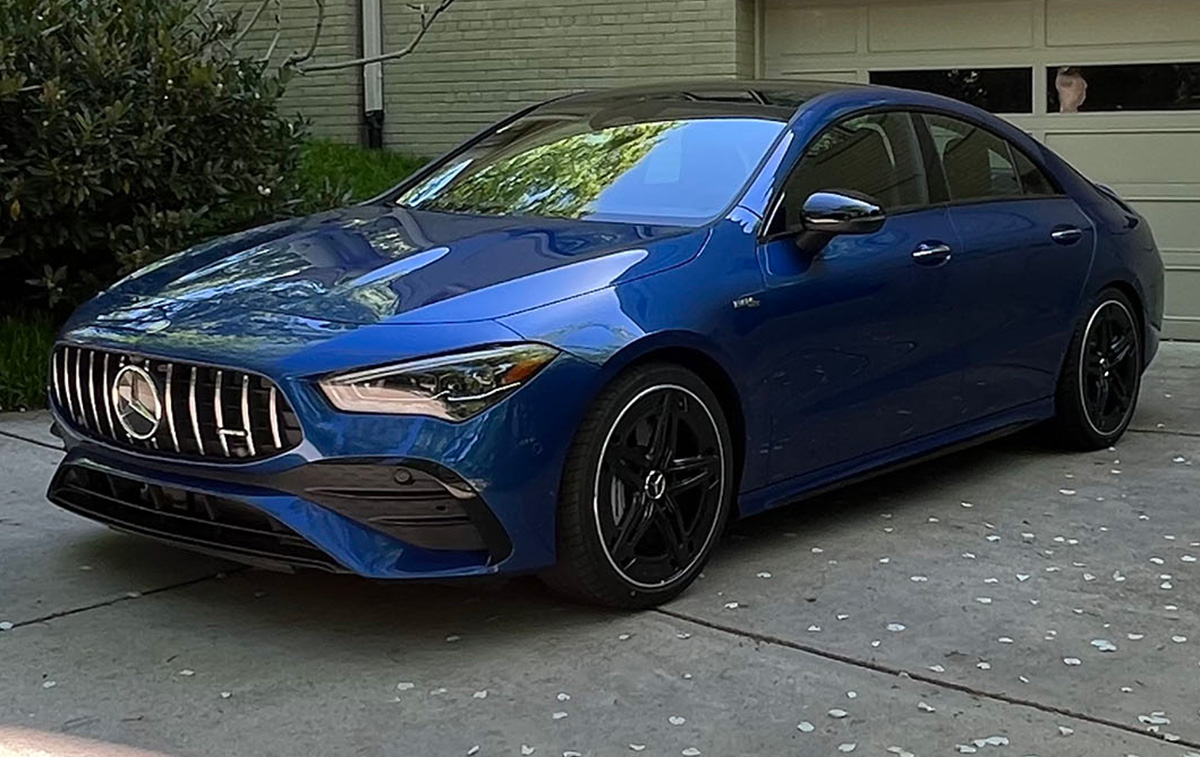
$58,000
MPG: 22 city/29 highway
0 to 60 mph: 4.8 seconds
Cargo space: 11.6 cu. ft.
PROS: Slick styling. Spiffy cabin. Sublime seats.
CONS: Smallish trunk. So-so rear headroom and legroom.
IN A NUTSHELL: Need a smaller sedan that’s just as marvy as the midsize BMW i530? Look no further than the compact Mercedes CLA-Class, which is 14 inches shorter. That’s a benefit when jockeying for parking or navigating rush hour.
Another plus: This is Mercedes’s least expensive sedan, available in three trim levels. All come with the same potent turbo but in varying power levels. The base model starts at $46,000, but I tested the first of two high-performance versions: the AMG CLA 35, which costs $12,000 more. You can open your wallet even further to snag the $67,000 AMG CLA 45.
But why bother? The AMG CLA 35 is plenty quick — faster than the BMW i530 — and boasts sport-tuned brakes, deft handling and a gritty-sounding exhaust system. The laundry list of standard features includes all-wheel drive, automated parking, gobs of the latest safety gizmos and even something called “safe-exit assist,” which prevents passengers from opening a door into traffic or speeding cyclists.
The interior is pure Mercedes, with top-notch materials, customizable ambient lighting and Burmester surround-sound audio. The overall layout—sleek and modern, but with elegant stitching in the seats and on the door panels and dashboard—is comfortable and user-friendly. Digital displays and touchscreens are similar to what’s in the BMW i530, just smaller.
Size matters, of course, which is why this vehicle’s shorter length can be a blessing but also a curse, especially when trying to squeeze passengers with longer legs into the backseats. And the dramatically sloped roofline, attractive from the outside, limits the amount of rear headroom and cargo space. Thank the automotive gods for panoramic sunroofs, which—at least for anyone in the front seats—makes this cabin feel surprisingly spacious.
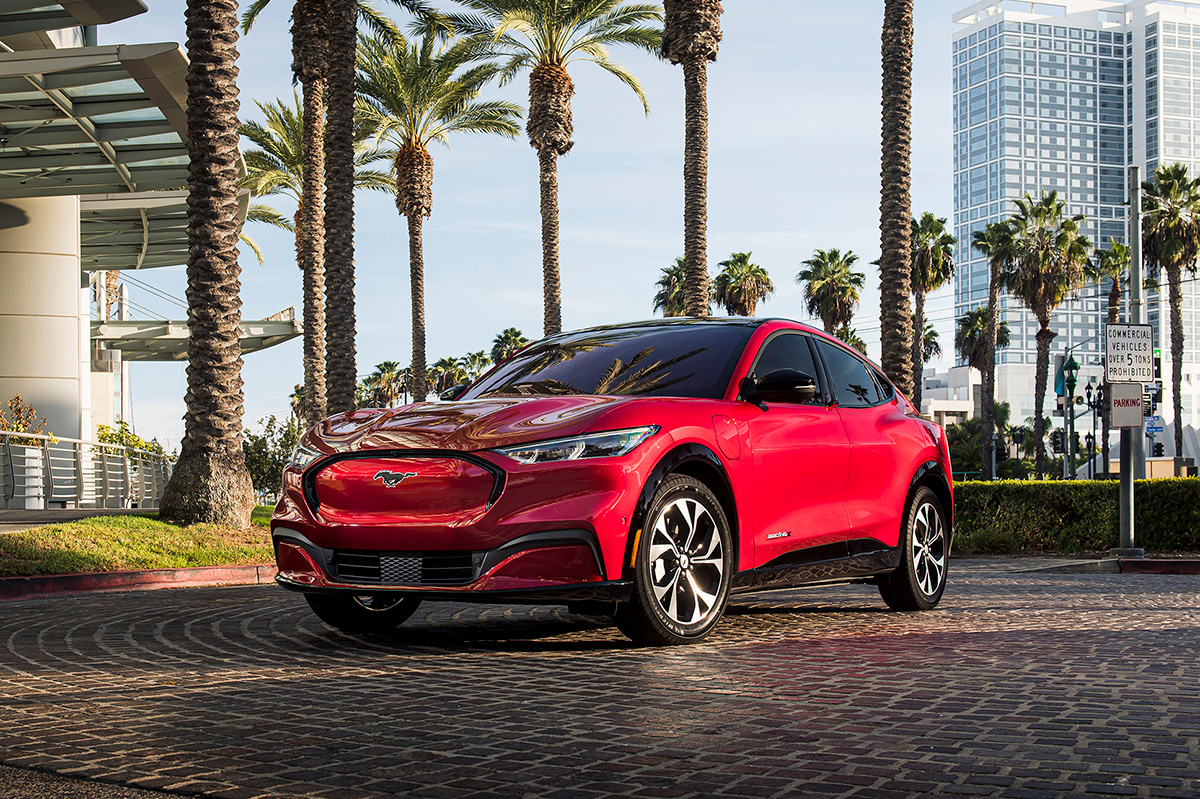
Looking to roll into something new? With all the buzz about 25% tariffs, it’s the perfect time to grab a new ride before prices soar—especially for electric vehicles, which may soon wave goodbye to those oh-so-attractive federal tax credits. Whether you are an eco-conscious commuter or just need a chariot for weekend getaways, these three green machines offer some serious swagger.
FORD MUSTANG MACH-E PREMIUM
$42,000
Range: 250-300 miles (depending on battery pack)
0 to 60 mph: 5.2 seconds
Cargo space: 29.7 cu. ft.
PROS: Zippy. Sporty feel. Ample battery range.
CONS: Bit bumpy over potholes. Limited seat adjustments.
IN A NUTSHELL: With sleek curves and a design that’s hotter than a drag queen’s heels on the runway, the Ford Mustang Mach-E blends both power and flair. The exterior colors are vibrant and unapologetically bold, just like the rainbow after a storm. Three trim levels, but opt for the spiffy Premium version—which was what I drove and is a nice step up from the $37,000 base model. It also costs a lot less than the gutsy GT, which tops $55,000.
Inside, the Mach-E is like driving a chic lounge on wheels. Toggling through the 15.5-inch touchscreen feels like navigating through the latest TikTok trends. A panoramic glass roof and faux-leather upholstery come standard, but assorted add-ons—standard features with the Premium trim—include hands-free power liftgate, multicolor ambient lighting and 10-speaker Bang & Olufsen stereo. There’s also plenty of space for all the essentials: totes, coats and besties.
And let’s not forget about battery range—there’s enough juice here to take you through a whole day of driving without needing a recharge. With Ford’s fast-charging network, it’s easy to be powered up quicker than you can say, “Ride ‘em, cowboy!” Well, almost.
How popular is this EV, which looks more like a hot hatchback than an SUV? Last year, sales spiked 27% and outsold the iconic gas-powered Mustang. So yes, the Mach-E Premium isn’t just any vehicle—it’s an experience that’s, well, electric.
KIA SPORTAGE PHEV X-LINE PRESTIGE
$44,000
MPGe: 84 city/highway combined
0 to 60 mph: 7.1 seconds
Cargo space: 39.6 cu. ft.
PROS: Comfy. Comely cabin. Oodles of passenger room.
CONS: Clunky dual-use dashboard controls. Bit noisy interior.
IN A NUTSHELL: Next up: the 2025 Kia Sportage PHEV X-Line Prestige, a compact plug-in hybrid that combines style, strength and versatility into one dazzling package. If the Mach-E Premium is a glam EV star, I found the Sportage PHEV to be an SUV showstopper.
Under the hood, power comes from an electric motor and gas-powered backup, so you get the best of both worlds—whether cruising on green energy or unleashing your inner diva. The all-electric range is almost 35 miles, and all-wheel drive is standard—which helps keep things steady, no matter the weather.
Inside, it’s pure comfort. While there are two hybrid trim levels, even the base-model—the X-Line—is fairly loaded: LED headlights/taillights, dual-zone automatic climate control, remote start, power liftgate, nav system, wireless charging pad, smartphone integration and more.
For my weeklong test vehicle, I was spoiled with the X-Line Prestige, which is full of a ridiculous number of amenities and safety gear. Let’s just say the clever cabin design would make the folks at Ferrari blush. Oh, and thanks to the pristine acoustics from the Harmon Kardon audio, I could have sworn the cast of “Hamilton” was right there with me belting out each tune. “Blow Us All Away,” indeed.
MERCEDES AMG C 63 S E
$87,000
MPGe: 40 city/highway combined
0 to 60 mph: 3.3 seconds
Cargo space: 11.6 cu. ft.
PROS: Snazzy. Lightning fast. Haute handling.
CONS: Pricey. Quirky steering-wheel controls.
IN A NUTSHELL: Jonesing for an exciting, eco-friendly sedan? Then look no further than the Mercedes AMG C 63 S E plug-in hybrid, which gets the adrenaline pumping each time you slip behind the wheel.
Under the hood, there’s a staggering 671 horsepower—enough to leave competitors in the dust and make them more than a little jealous. This AMG-tuned Mercedes—the quickest C-Class ever—blasts from 0 to 60 mph in just 3.3 seconds, faster than your heart rate when seeing your next crush at a circuit party. And that’s not even the best part—the shapely contours of this sportster are as chiseled as Luke Evans’ check bones.
Inside, the cockpit is like a designer outfit made for a fab night out—high-quality material everywhere, as well as branded sport seats with top-tier upholstery and stitching. One downside: the steering-wheel controls, which look tasteful but can be a tad too touch-sensitive at times.
Still, this elegant ride exudes more than enough bells and whistles to maintain a constant state of euphoria.
Autos
Mad about Mercedes — and a Mini Countryman, too
These three spiffy SUVs not too basic, not too complicated
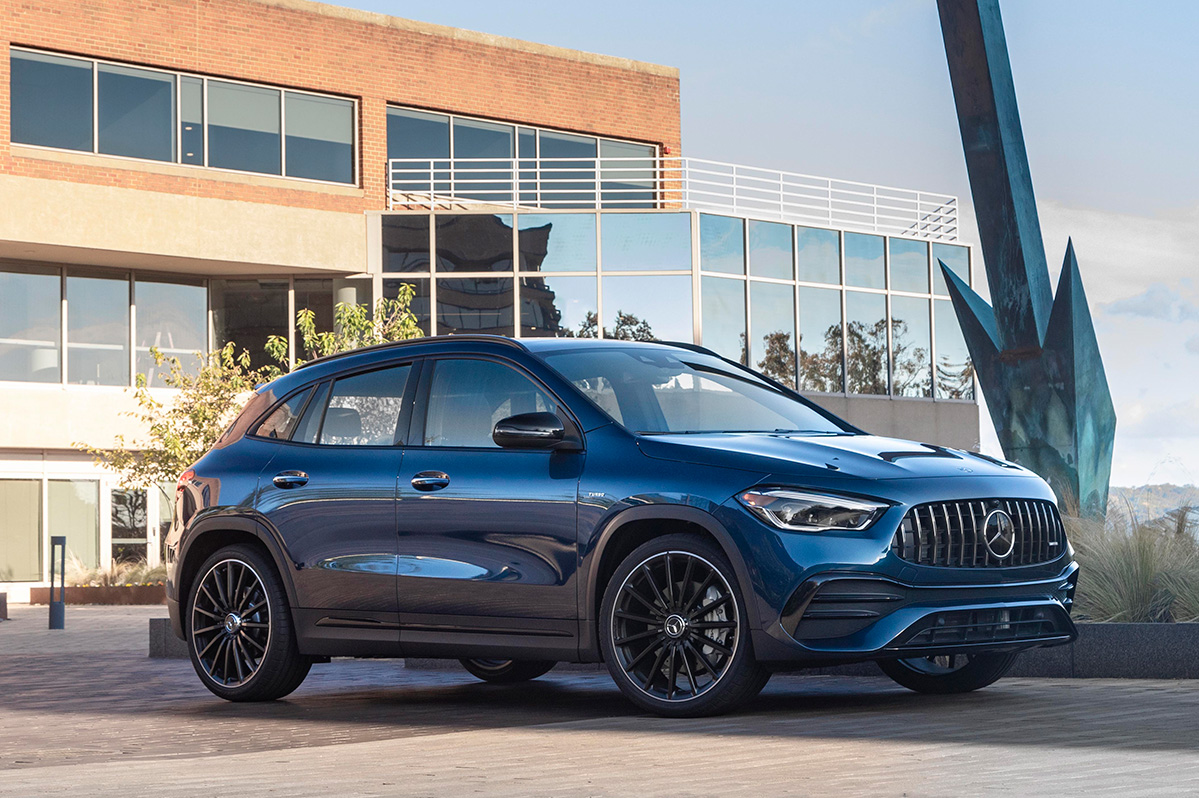
Not too basic, not too complicated. That’s what I enjoyed most about three spiffy SUVs recently. Call it the Goldilocks effect, but each ride—two Mercedes and a Mini Countryman—seemed just right. That’s a big plus in today’s world of extremes.
MERCEDES AMG GLA 35
$59,000
MPG: 22 city/28 highway
0 to 60 mph: 4.7 seconds
Cargo space: 15.4 cu. ft.
PROS: Affordable luxury, smooth suspension, zippy.
CONS: Bit noisy inside, so-so storage, costly options.
IN A NUTSHELL: The subcompact GLA—the most affordable Mercedes sold in the U.S.—comes in two trim levels. With the average price of a vehicle topping $48,000, the base-model GLA 250 is a bargain at $43,000. On paper, the stats for acceleration, handling and braking look spot on. Ditto the fine amenities, including faux-leather seats, ambient lighting, wireless charging pad and power liftgate. Toss in numerous safety features—including forward-collision warning, blind-spot alert, an automated parking system—and what could be better? The answer is the sport-tuned AMG GLA 35, which is the vehicle I tested. Zippier, grippier and ritzier than its entry-level sibling, this saucy SUV is also pricier. And beware: The long list of options—such as head-up display, surround-view camera, illuminated door sills—can add up quickly. But oh, what a thrill. Stomp on the accelerator, and the GLA 35 scoots from 0 to 60 mph in just 4.7 seconds—a full two seconds quicker than the GLA 250. Along with a more powerful engine and all-wheel drive, there’s now a 48-volt hybrid-assist system. The GLC 35 also flaunts aggressive styling, including a sexy rear spoiler, large dual exhaust tips and bigger wheels. Fave feature: the flat-bottom, performance-oriented steering wheel with spiffy paddle shifters and a panoply of user-friendly buttons and dials.
MERCEDES AMG GLC 43 COUPE
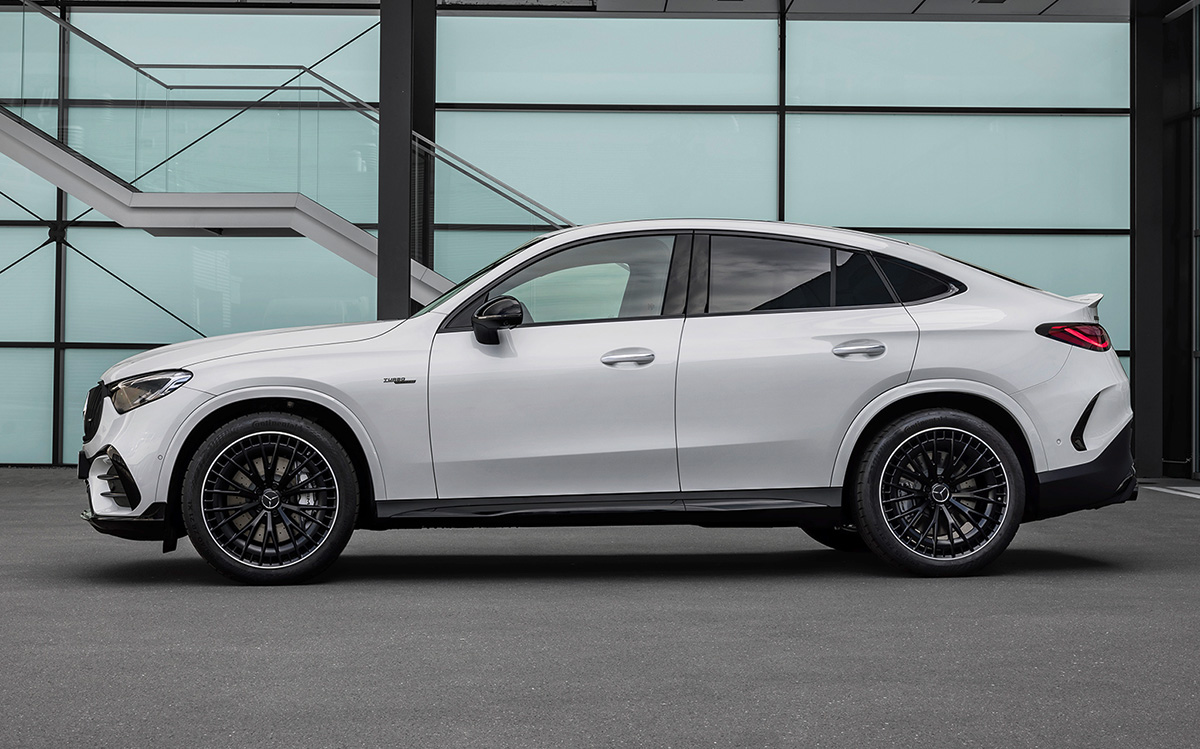
$70,000
MPG: 18 city/24 highway
0 to 60 mph: 4.7 seconds
Cargo space: 19.2 cu. ft.
PROS: Posh styling, potent power, quiet cabin.
CONS: Pricey, limited rear visibility, reduced cargo room.
IN A NUTSHELL: Stepping up from the baby Mercedes GLA, the larger GLC—though technically a compact—is 12 inches longer. What’s more, this hauler comes with choice of five trim levels. And you can choose from either a traditional square-back design or sloped coupe-like styling. Confused? Don’t be. Just trust that the AMG GLC 43 Coupe, which is really an SUV, checks all the boxes. There’s plenty of drama here, with a bulging snout and sinuous shape that any diva would love. There’s also plenty of power, with a gritty turbo that allows the GLC to accelerate just as fast as the much lighter GLA. And the interior is stunning: NASCAR-like bucket seats, gigantic infotainment touchscreen and reinforced window glass to better insulate the cabin. A clever nav system can project traffic and other info onto the head-up display on the windshield, and rear automatic braking helps anticipate and prevent a back-end collision. Sure, the low-slung roofline cuts into rear-seat headroom and cargo space. But for me, the sacrifice was worth it. After all, it’s hard to imagine any other glam-but-gutsy ride equally at home on a fashion runway or at the racetrack.
MINI COUNTRYMAN ALL4
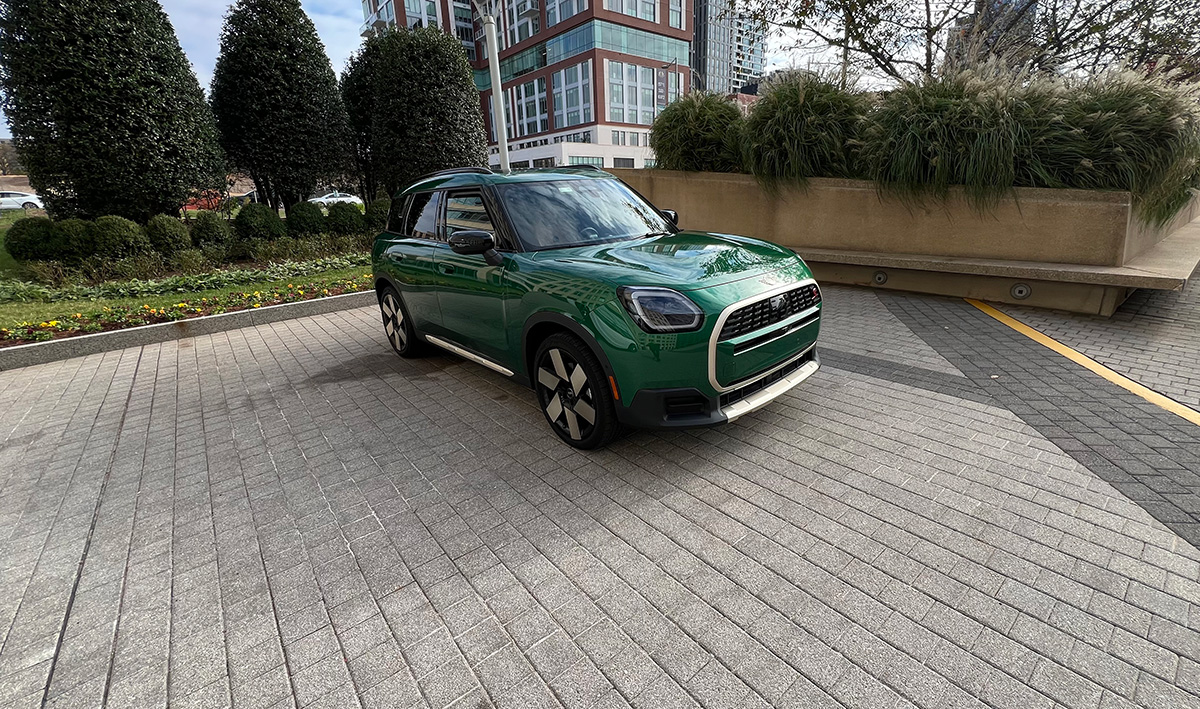
$40,000
MPG: 24 city/32 highway
0 to 60 mph: 5.9 seconds
Cargo space: 24.9 cu. ft.
PROS: Bigger, faster, better.
CONS: Almost too big, bit less playful, higher MSRP.
IN A NUTSHELL: Fully redesigned for 2025, the Mini Countryman enjoys a slew of up-market changes but retains some of its retro quirks. Larger than before, this latest model—with so much extra room for passengers and cargo—feels comfy and spacious. Almost too much so. At first blush, I was reminded of a Subaru Forester or Outback. Both fine vehicles, but without that familiar Mini vibe. Luckily, the steering wheel, head-up display and large Frisbee-shaped infotainment display all channel the previous Countryman. Ditto the overall exterior, which now boasts a redesigned grille, sleeker headlights and refined rear treatment. Yet I missed seeing all the toggle switches and some other playful touches. In their place, though, is a groovy dashboard with nifty LED lighting that changes colors based on the driving mode. While some digital readouts initially seemed too techy, they ended up being very user friendly. And there are two standout features: a huge panoramic moonroof and the use of sustainable materials for the carpeting, seats and such.
-

 State Department5 days ago
State Department5 days agoHIV/AIDS activists protest at State Department, demand full PEPFAR funding restoration
-

 District of Columbia5 days ago
District of Columbia5 days agoCapital Pride wins $900,000 D.C. grant to support WorldPride
-

 Obituary4 days ago
Obituary4 days agoLocal attorney, LGBTQ rights advocate Dale Sanders dies at 75
-

 U.S. Federal Courts3 days ago
U.S. Federal Courts3 days agoFederal judge blocks Trump passport executive order






